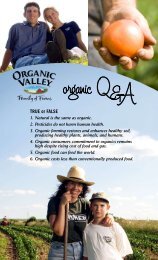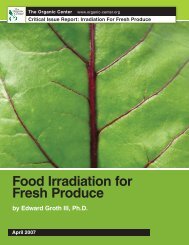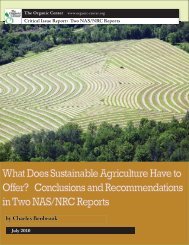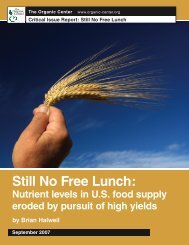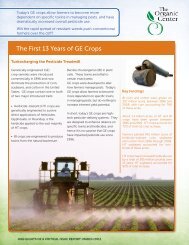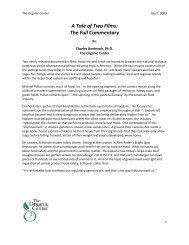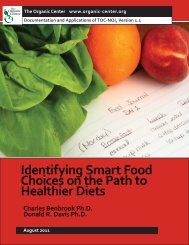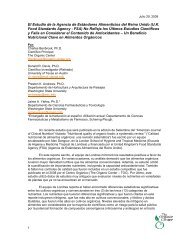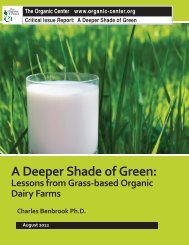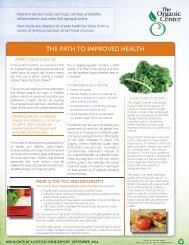Organic Food Production Talking Points - Hunger and ...
Organic Food Production Talking Points - Hunger and ...
Organic Food Production Talking Points - Hunger and ...
You also want an ePaper? Increase the reach of your titles
YUMPU automatically turns print PDFs into web optimized ePapers that Google loves.
<strong>Hunger</strong> <strong>and</strong> Environmental Nutrition DPG<br />
Introduction<br />
<strong>Organic</strong> food is the fastest growing segment of the food industry. More organic food is entering the mainstream food<br />
distribution system <strong>and</strong> consumers are becoming interested in the origins of their food. They are asking more<br />
sophisticated questions <strong>and</strong> searching for information about the food supply from food <strong>and</strong> nutrition professionals.<br />
The purpose of this document is to provide food <strong>and</strong> nutrition professionals, ADA Media Representatives <strong>and</strong><br />
Spokespersons with information that they can utilize to speak knowledgeably about organic food production when<br />
speaking with the news media. <strong>Organic</strong> foods are products of a holistic system that is closely regulated <strong>and</strong> monitored by<br />
law:<br />
• <strong>Organic</strong> <strong>Food</strong>s <strong>Production</strong> Act of 1990, Public Law 101-624 (http://agriculture.senate.gov/Legislation/<br />
Compilations/AgMisc/OGFP90.pdf).<br />
Water, soil <strong>and</strong> air quality, environmental preservation <strong>and</strong> enhancement, biodiversity, humane animal treatment, safety<br />
for farm labor, <strong>and</strong> energy conservation are all integral to an organic system. Nutrition is one component of the system<br />
<strong>and</strong> an emerging area of research in this field.<br />
The information in this document is presented in two forms. Following the introduction there is a user friendly single page<br />
of concise talking points drawn from the research. The talking points are divided into information about organic farming<br />
systems that have a large body of research followed by information about areas that require further research. The second<br />
section contains more detailed explanations <strong>and</strong> specific annotated references to the literature that support the basic<br />
concepts presented in the talking points.<br />
This document was prepared by an Ad Hoc committee of members from the <strong>Hunger</strong> <strong>and</strong> Environmental Nutrition DPG#15<br />
(www.hendpg.org):<br />
• Helen Costello, MS, RD, LD, 2006-2007 HEN DPG Chair<br />
• Mary Jo Forbord, RD<br />
• Alison Harmon, PhD, RD<br />
• Keecha Harris, DrPH, RD<br />
• Christine McCullum-Gomez, PhD, RD, LD<br />
• Anne Patterson, RD, LDN<br />
The committee wishes to acknowledge <strong>and</strong> thank our external content reviewers:<br />
• James Riddle, Past-Chair of the United States National <strong>Organic</strong> St<strong>and</strong>ards Board (NOSB) <strong>and</strong> <strong>Organic</strong> Outreach<br />
Coordinator, University of Minnesota (www.organicecology.umn.edu).<br />
• Chuck Benbrook, PhD, Chief Scientist, The <strong>Organic</strong> Center (www.organic-center.org). Former Executive Director,<br />
Board of Agriculture, National Academy of Sciences.<br />
This document was created June, 2006 <strong>and</strong> revised April, 2007.<br />
<strong>Organic</strong> <strong>Food</strong> <strong>Production</strong> <strong>Talking</strong> <strong>Points</strong> - April 2007! ! ! 2



